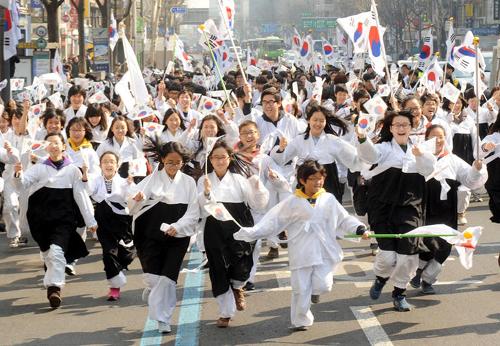by REERA YOO | @reeraboo
reerayoo@gmail.com
South Koreans on Sunday celebrated the 96th anniversary of the March First Movement, also known as the Sam-il Movement, a series of demonstrations for Korean national independence from Japanese colonial rule.
Origin
 The signing of the Korean Declaration of Independence (Image via LoveKorea)
The signing of the Korean Declaration of Independence (Image via LoveKorea)
In 1910, the Korean peninsula was officially annexed by the Japanese Empire, marking the end of the Joseon Dynasty. Under Japanese rule, Koreans were required to speak Japanese and adopt Japanese names. As a result, Korean culture and traditions began to diminish.
About a month after the sudden death of former Korean Emperor Kojong on Jan 21, 1919, a group of Korean students studying in Tokyo published a statement demanding Korea’s independence, which was inspired by U.S. President Woodrow Wilson’s “Fourteen Points” speech at the Paris Peace Conference. Many Koreans believed that Kojong was poisoned as there had been previous assassination attempts, such as the “coffee plot.”
The Movement
 Pagoda Park during the March First Movement (Photo via Lucas Stories)
Pagoda Park during the March First Movement (Photo via Lucas Stories)
On March 1, 1919 at 2 p.m., 33 leaders of the independence movement convened at the Taehwagan Restaurant in Seoul and read the Korean Declaration of Independence, launching a series of nonviolent protests across the country.
The leaders initially wanted to meet at Tapgol Park, also known as Pagoda Park, but chose to meet at a more private location in order to prevent a riot. However, massive crowds appeared at the park to hear a student named Chung Jae-yong read the declaration and held a peaceful procession. Caught off guard, the Japanese authorities could not control the growing crowd and were forced to call military forces to quell the protest on March 1.
The Massacre
 Illustration of the Jeam-ri Massacre (Image via KC Times)
Illustration of the Jeam-ri Massacre (Image via KC Times)
As the public protests continued to grow, the Japanese government’s response became increasingly more violent, resulting in massacres and mass imprisonment. One notable incident was the Jeam-ri Massacre. On April 15, 1919, the Japanese police drove at least 29 village residents of Jeam-ri into a church and set the building on fire after barring the doors. There were no survivors.
Approximately 2,000,000 Korean protesters, many of whom were civilians, had participated in more than 1,500 nonviolent protests before the Japanese brutally suppressed the movement. According to the book Bloody History of the Korean Independence Movement by Park Eunsik, about 7,509 people killed, 15,849 wounded and 46,303 arrested by the Japanese during the independence movement. Many of the arrested protesters were sent to Seodaemun Prison, where they were tortured and faced death without trial or due process.
Impact
Although the March First Movement failed to achieve the immediate independence of Korea, it promoted change. After the campaign, the Japanese colonial government briefly allowed Koreans to write and distribute Korean literature under the “cultural policy.” However these lenient policies were later reversed during World War II.
Since 1949, March 1 has been celebrated as a national holiday that commemorates the courage and sacrifices of those who died and suffered for the independence movement. Today many Koreans celebrate this holiday by distributing South Korean flags and participating in re-enactments of the nonviolent processions while shouting “manse,” which translates to “hooray” in English.
___
Featured image via Gwangju Blog







